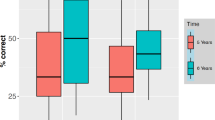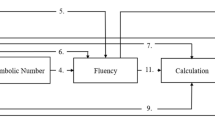Abstract
Observations were made of the progressive change in the cognitive development of 141 students over the course of their secondary education in an Australian private school. Cognitive development was measured in years 8, 10 and 12 usingBond's Logical Orerations Test. Rasch analysis of each of the data sets provided ability estimates for students in the year groups of 1993 (year 8), 1995 (year 10) and 1997 (year 12). Twenty-nine students from the year group of 1993 were tested on all three occasions. We analysed data from these 29 students in order to investigate the children's cognitive development across years 8, 10 and 12. We also examined the influence of the Cognitive Acceleration through Science Education (CASE)Thinking Science program on the cognitive development and scholastic achievement of these students. We found increased mental growth between years 8 and 10 for most students in theThinking Science cohort, which could not be predicted from their starting levels. There was a significant correlation between cognitive development and the scholastic achievement of these students. Although boys as a group were more advanced in cognitive development than girls in years 8 and 10, no difference was found in the rate of cognitive change based on sex up to year 10. However girls showed cognitive gains across years 10–12 which were not found in boys. The students who were new to the school also showed increased cognitive development in years 11 and 12. Students who had experienced theThinking Science course were more cognitively developed than students who joined the school after the intervention had taken place. This study supports the claim of Adey and Shayer that there is a relationship between cognitive development and scholastic achievement, even though we used different measures of cognitive development and scholastic achievement.
Similar content being viewed by others
References
Adams, R. J., & Khoo, S-T. (1993).Quest: the Interactive Test Analysis System. Hawthorn, Victoria: Australian Council for Educational Research.
Adey, P. (1992). Gender differences in the application of intellectual processes.Studia Psychologica, 34, 225–245.
Adey, P., & Shayer, M. (1990). Accelerating the development of formal thinking in middle and high school students.Journal of Research in Science Teaching, 27, 267–285.
Adey, P., & Shayer, M. (1994).Really raising standards. London: Routledge.
Adey, P., Shayer, M., & Yates, C. (1989). Cognitive acceleration: The effects of two years of intervention in science classes. In P. Adey (Ed.),Adolescent development and school science (pp. 240–248). Lewes, UK: Falmer Press.
Adey, P. S., Shayer, M., & Yates, C. (1995).Thinking science (2nd ed). London: Nelson.
Andrich, D. (1988).Rasch models for measurement. Newbury Park, CA: Sage.
Bond, T. G. (1976),The development, validation and use of a test to assess Piaget'sf Formal stage of logical operations. Unpublished doctoral thesis, James Cook University of North Queensland, Townsville, Australia.
Bond, T. G. (1989). An investigation of the scaling of Piagetian formal operations. In P. Adey (Ed.),Adolescent development and school science (pp. 334–341). Lewes, UK: Falmer Press.
Bond, T. G. (1995a). Piaget and measurement I: The twain really do meet.Archives de Psychologie, 63, 71–87.
Bond T. G. (1995b). Piaget and measurement II: Empirical validation of the Piagetian model.Archives de Psychologie, 63, 155–185.
Bond, T. G., & Fox, C. M. (in press).Applying the Rasch model: Fundamental measurement in the human sciences. Mahwah, NJ: Erlbaum.
Christiansson, D. J. (1983).An investigation of the relationship between cognitive developmental stage and quantitative skills in college students. Unpublished doctoral dissertation, University of the South Pacific, Fiji.
Hautamäki, J. (1989). The application of a Rasch model on Piagetian measures of stages of thinking. In P. Adey (Ed.),Adolescent development and school science (pp. 342–350). Lewes, UK: Falmer Press.
Inhelder, B., & Piaget, J. (1955/58).The growth of logical thinking from childhood to adolescence: An essay on the construction of formal operational structures. London: Routledge & Kegan Paul.
Jackson, S. (1965). The growth of logical thinking in normal and subnormal children.British Journal of Educational Psychology, 35, 255–258.
King, J., & Bond, T. G. (1996). A Rasch analysis of a measure of computer anxiety.Journal of Educational Computing Research, 14, 49–65
Kuhn, D., & Angelev, J. (1976). An experimental study of the development of formal operational thought.Child Development, 47, 607–706.
Lawson, A. E., & Blake, A. J. D. (1976). Concrete and formal thinking abilities in high school biology students as measured by three separate instruments.Journal of Research in Science Teaching, 13(3), 227–235.
Lawson, A. E., & Snitgen, D. A. (1982). Teaching formal reasoning in a college biology course for preservice teachers.Journal of Research in Science Teaching, 19, 233–248.
Lovell, K. (1961). A follow up of Inhelder and Piaget'sThe Growth of Logical Thinking.British Journal of Educational Psychology, 52(2), 143–153.
Rosenthal, D. A. (1979). The acquisition of formal operations—the effect of two training procedures.Journal of Genetic Psychology, 134, 125–140.
Shayer, M. (1998). The long term effects of cognitive acceleration on pupils' school of achievement (Online). Available http://www.thenerve2.com/ca/NewRes.html (September 1, 1998)
Shayer, M., & Adey, P. (1981).Towards a science of science teaching. London: Heinemann.
Shayer M., Küchemann, D. E., & Wylam, H. (1976). The distribution of Piagetian stages of thinking in British middle and secondary school children.British Journal of Educational Psychology, 46, 164–173.
Shayer, M., & Wylam, H. (1978). The distribution of Piagetian stages of thinking in British middle. and secondary school children. II 14- to 16- year olds and sex differentials.British Journal of Educational Psychology, 48, 62–70.
Smith, L., & Knight, P. (1992). Adolescent reasoning tests with history content.Archives de Psychologie, 60, 225–242.
Author information
Authors and Affiliations
Corresponding authors
Rights and permissions
About this article
Cite this article
Endler, L.C., Bond, T. Cognitive development in a secondary science setting. Research in Science Education 30, 403–416 (2000). https://doi.org/10.1007/BF02461559
Issue Date:
DOI: https://doi.org/10.1007/BF02461559




